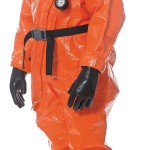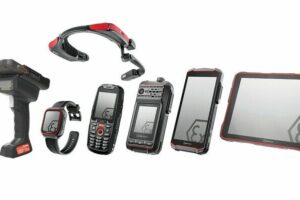Whether for control measurements, refilling work or emergency applications: working with hazardous goods or substances places high demands on the employee as well as on the material. In order to be prepared for these dangers, users have a broad portfolio of protective clothing at their disposal which is continuously extended and adapted to various requirements.
The author: Stefan Denker Business Development Manager Industry, Dräger Safety
A risk analysis is always the first step in ensuring the best possible protection for employees. The purpose of this analysis is to examine the work conditions and identify possible dangers. Based on this, each user selects the most suitable protective clothing. Splash protective clothing, which protects the wearer from liquids and particles, is suitable for simple tasks. However, a gas-tight chemical protective suit is essential for handling gases. Up to now it has not been possible to cover all requirements easily with the existing portfolio. Cryogenic substances are just one example. In the past, contact was simply avoided or additional clothing worn. Unfortunately, this is uncomfortable and limits the wearer’s freedom of movement significantly. Dräger is continuously striving to find new technologies and solutions to close these gaps. One of the many core areas is joint research with users. ’More than 100 volunteer testers worldwide took part in our chemical protective suit development projects from 2008 to 2011’, explained Robert Betzinger, portfolio manager at Dräger responsible for chemical protective suit applications in the industry. ’During this process, we considered not only the users who wear the protective suits but also their typical application conditions.’ Potential changes were discussed concerning the material, design and equipment of the suits as well as the basic concept. Modern materials have replaced traditional alternatives such as neoprene and Viton butyl.
Innovative suit material
CPS 7900 and CPS 7800, the newest generation of chemical protective suits by Dräger, are made from D-mex, a five-layer material. The middle layer comprises a tear-proof textile. On the outside and inside are an especially sturdy elastomer layer and a highly chemical-resistant barrier layer. The suits maintain their protective effect even if the material on the outside is damaged and provide high flexibility during work with liquefied gases down to a temperature of -80 °C. They are also resistant to explosive flames according to NFPA 1991.
Work in potentially explosive atmosphere is another major issue. ’This is a twilight zone because there are currently no standards or EN regulations for it’, Betzinger continued. ’There are Atex approvals for thermal imaging cameras and gas detectors, but not for chemical protective suits.’ The static electricity in potentially explosive atmosphere is a real danger, however, and this problem has now also been solved by the new material: ’The material components prevent static charging. The new suits are non-conducting to such an extent that no voltage can build up.’
High wearing comfort
Parallel to the protective effect, maintainability and ergonomics also play an important role, of course. The working conditions are extremely challenging for wearers of chemical protective suits. This is obvious to anyone who dons a gas-tight chemical protective suit while wearing self-contained, open-circuit breathing appa-ratus on his back and then attempts to grasp and install small parts with the thick protective gloves in order to carry out a complex repair task. Freedom of movement, vision and fine motor skills are greatly restricted. The microclimate inside the suit, which is characterised by quickly increasing moisture and heat, is another drawback. Any innovation which simplifies the user’s task is therefore extremely valuable. External sources of air can be used during decontamination or cleaning work, for example. If additional breathing air is available, the application time can be extended as necessary, so that it is possible to remove hazardous substances from the suit thoroughly and without any pressure of time. The suit can be removed safely by the user regardless.
Apart from the time saving, the external air supply also enables the suits to be ventilated. The ventilation tubes on the inside exhaust the humid, warm air and improve the microclimate, thus reducing the physical load on the wearer. This function is offered for all gas-tight suits made by Dräger.
The fit of the suit also helps to ensure the highest possible wearing comfort. CPS 7900 and CPS 7800 are available in five different sizes, for instance, so that wearers between 1.50 and 2 m tall are guaranteed considerable freedom of movement during a variety of activities.
The durability and maintainability of the suit are further significant factors. Reusable suits such as CPS 7900 and CPS 7800 are characterised by robust materials and components. Lim-ited-use suits are a less rugged but cost-efficient alternative. Owing to their mechanical properties, they should only be used for low-risk applications, such as performing control measurements or refilling. CPS 5900 and CPS 5800 were developed by Dräger specifically for applications of this kind. Both suits afford far-reaching protection from a multitude of industrial chemicals. Their resistance to mechanical influences and flames, on the other hand, cannot match that of the reusable CPS 7900 and CPS 7800, and they only have a service life of ten years as compared to fifteen years for the reusable models.
Hall 9.1, Booth C83
cpp-net.com/0212469
Five questions on the way to the perfect suit
Optimal protection
In order to guarantee exactly the right protection from a particular suit, there are five questions every wearer should answer:
- Which hazardous substances are you exposed to during your work? If you know the hazardous substances, you can take targeted measures to protect yourself. If not, you should always assume the worst case scenario and select the highest level of protection.
- Are you required to wear breathing apparatus during your work? If breathing apparatus is not required, a simple overall is sufficient. If you work with filtration apparatus, it is best to use a suit equipped with an integrated full-face mask or facial cuff. If you need compressed air breathing apparatus, make sure the equipment can be worn comfortably either over or under your protective suit.
- What is the nature of your work environment? A protective suit with a higher mecha-nical strength is recommended if your work environment is unpredictable. If damage is unlikely, a limited-use suit can be a good alternative. When working in confined spaces, such as a tank with a manhole, you should preferably choose a close-fitting suit and wear the compressed air apparatus over it.
- How easily can the pollution caused by the hazardous substance be removed again (decontamination)? If the hazardous substance is difficult to remove from surfaces, you should wear the breathing apparatus on the inside of the protective suit.
- Which risks are associated with the hazardous substance? If the hazardous substance is very cold, such as liquefied gas, the suit material must not become brittle or break when exposed to the cold. If it is flammable at ambient temperatures, the protective suit must be flame-resistant. If the hazardous substance is a toxic gas, a gas-tight suit should always be worn and never a splash suit.
Share:











